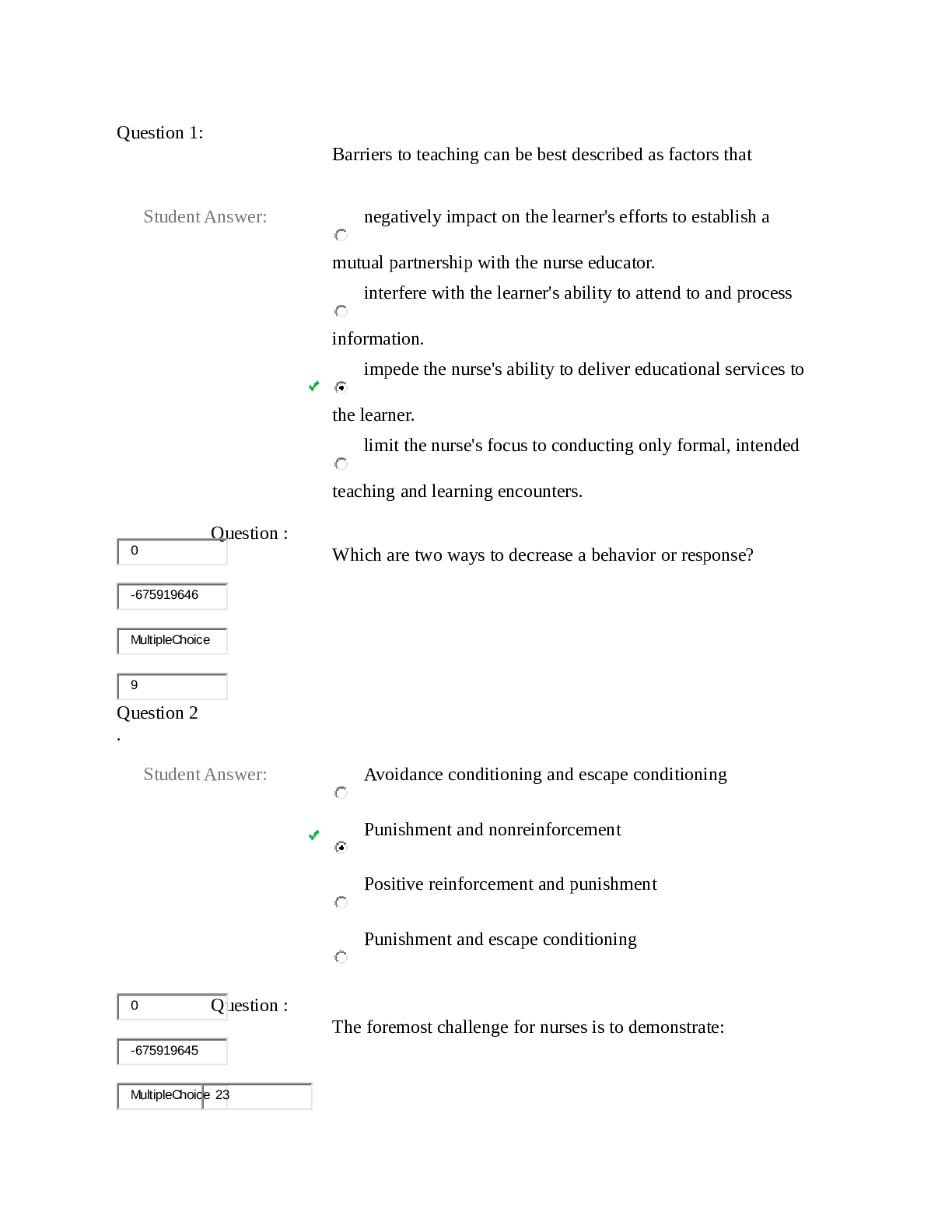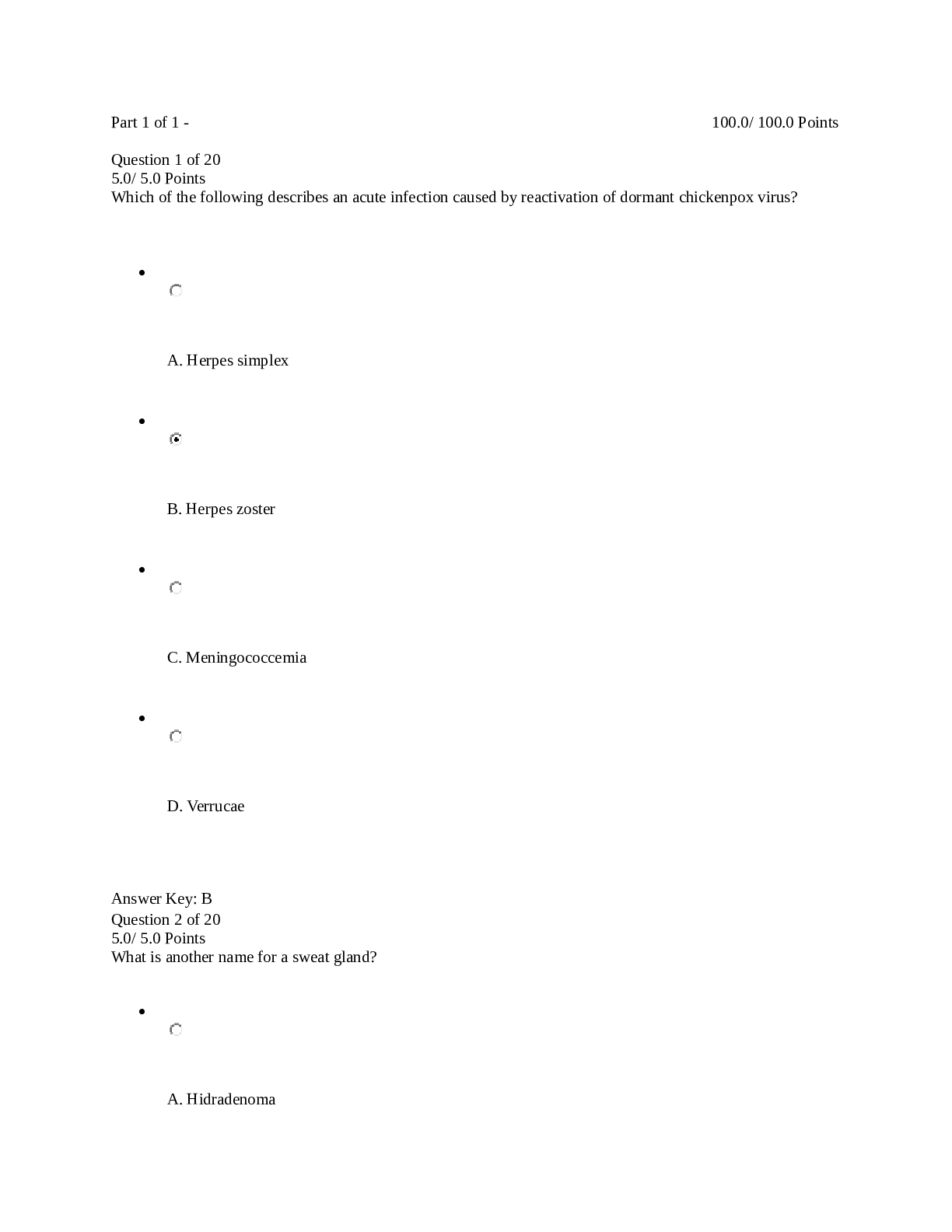Education > QUESTIONS & ANSWERS > FTCE Exceptional Student Education K12 (Competency 2) Latest 2022 Graded A (All)
FTCE Exceptional Student Education K12 (Competency 2) Latest 2022 Graded A
Document Content and Description Below
FTCE Exceptional Student Education K12 (Competency 2) Latest 2022 Graded A Assessment ✔✔The systematic gathering and analysis of information about students in order to make decisions that may be... nefit their educational experience. It is an ongoing process of monitoring student learning and identifying areas of strength and weakness. The ultimate goal is to improve student achievement, and thus it can be considered a formative activity. Screening Assessments ✔✔Are administered to all students in a particular group, such as a grade or a school. It is typically carried out at the beginning of the school year, as in the example of a vision screening administered to all incoming kindergarten students. The goal is to identify, as early as possible, students who may need extra academic support. Pre-Referral Assessments ✔✔Are administered to individual students before formally referring them for special education. They typically provide more information than what can be obtained through screening. It can be used to determine which instructional modifications are likely to help the student, and whether these modifications are successful (thereby allowing a formal referral for special education to be avoided in some cases). They can also be used to document the need for formal referral for special education, and may then become part of the student's IEP. Diagnostic Assessments ✔✔Are administered to individual students who may need extra support. In some cases, diagnostic assessments are used because screening has suggested the presence of a disability. In other cases, the diagnostic assessment is used because the student has already been referred for special education and more information is needed. They provide more in-depth understanding of a child's skills and instructional needs than screening assessments do. The goal is to determine areas of strength and weakness for a particular student. In some cases, the assessment is also designed to identify the nature of the student's disability. Progress Monitoring Assessments ✔✔Are used to determine whether an individual student's progress is adequate. It is conducted frequently over some finite period of time, and it often focuses on one specific academic area (e.g., reading fluency) or behavioral dimension (e.g., impulse control). The actual assessments used could be informal or formal and administered either before or after participation in special education services. Examples are the curriculum-based measurement approaches. Outcome Assessments ✔✔Are used to determine the extent of student achievement at the end of the school year or other significant time period. Example: state-mandated achievement tests. Accommodations ✔✔Adjustments to the way the assessments are administered. There are 4 types of accommodations: presentation, response, setting, and scheduling. Presentation Accommodations ✔✔Involves changes to the format of information presented in the assessment. Examples: increased sized font and response bubbles, increase spacing between items, highlighting key phrases in instructions, administration of assessment through a sign-language interpreter, audio recording, or tactile formats (Braille). Usually needs by students with visual or auditory impairments, or medication-related impairment. Response Assessments ✔✔Involves changes to the format by which the student provides responses to the assessment. Examples: use of a scribe to record student responses, audio recording, provision of response forms with added cues, allowing students to use a computer, allowing students to take notes prior to response, allowing students to mark answers without filling in bubbles. Usually needed by students with cognitive or physical impairments. Setting Accommodations ✔✔Involves changes to the location and/or conditions of the assessment. Examples: preferential seating, administration to small groups in separate settings, administration to individuals in separate settings, administration under conditions of special lighting or acoustics, administration in a location with minimal distractions. Usually needed by students with severe attentional problems, perpetual impairment, or a tendency to engage in behaviors that are highly distracting to others. Scheduling Accommodations ✔✔Involves changes to the timing and scheduling of assessments. Examples: allowing the assessment to be completed on separate occasions, allowing it to be completed at a particular time of day, allowing the order of the components to be varied, allowing frequent breaks, allowing consumption of specific foods, and allowing extends time. These accommodations may be needed by students with medical conditions that require distributed testing, extreme anxiety with respect to certain kinds of test content, and so on. Norm-Referenced Assessment ✔✔Provides results for an individual student that are related to norms, or results obtained from the student's peer group. Most results indicate the individual's performance level compared to others of the same age. A prominent norm-referenced assessment would be the Wechsler Intelligence Scale for Children (WISC-IV). Norm-referenced assessments are standardized , meaning get that their administration and scoring is both predetermined and consistent. Scores can be expressed in a familiar format such as percentile ranking. A CHILD WHOSE WISC-IV SCORE REPRESENTS THE 64th PERCENTILE HAS SCORED HIGHER THAN 63% OF CHILDREN OF THE SAME AGE WHO HAVE ALSO TAKEN THIS TEST. Criterion-Referenced Assessment ✔✔Compares individual's performance to some predetermined standard, or criterion. Examples of prominent criterion-referenced assessments include the "high stakes" achievement tests that all states administer in order to monitor student progress, such as the FCAT 2.0. Outcome assessments are almost always criterion-referenced. Individual-Referenced Assessment ✔✔Used to compare an individual's score at one point in time with the same individual's score at some other point or points in time. They may or may not be standardized. Progress monitoring assessments are often individual-referenced. An example would be the running record. Running Record ✔✔Teachers use this to track the progress of students in areas like reading. It's a student's performance across multiple administrations of the same task. Performance-Based Assessment ✔✔The student must exhibit some behavior or create some product requiring integration of knowledge and skills. Although guidance may be given, students do not simply choose among present options, and thus their behavior or product may need to be evaluated subjectively. Examples: a performance (musical piece), a demonstration (lab procedure), an essay, a project, a portfolio (collection of student's work during a semester). Validity ✔✔Refers to the extent to which an assessment measures what it is intended to measure. Criterion-Related Validity ✔✔Refers to t [Show More]
Last updated: 2 years ago
Preview 1 out of 7 pages
.png)
Buy this document to get the full access instantly
Instant Download Access after purchase
Buy NowInstant download
We Accept:

Reviews( 0 )
$10.00
Can't find what you want? Try our AI powered Search
Document information
Connected school, study & course
About the document
Uploaded On
Oct 20, 2022
Number of pages
7
Written in
Additional information
This document has been written for:
Uploaded
Oct 20, 2022
Downloads
0
Views
98










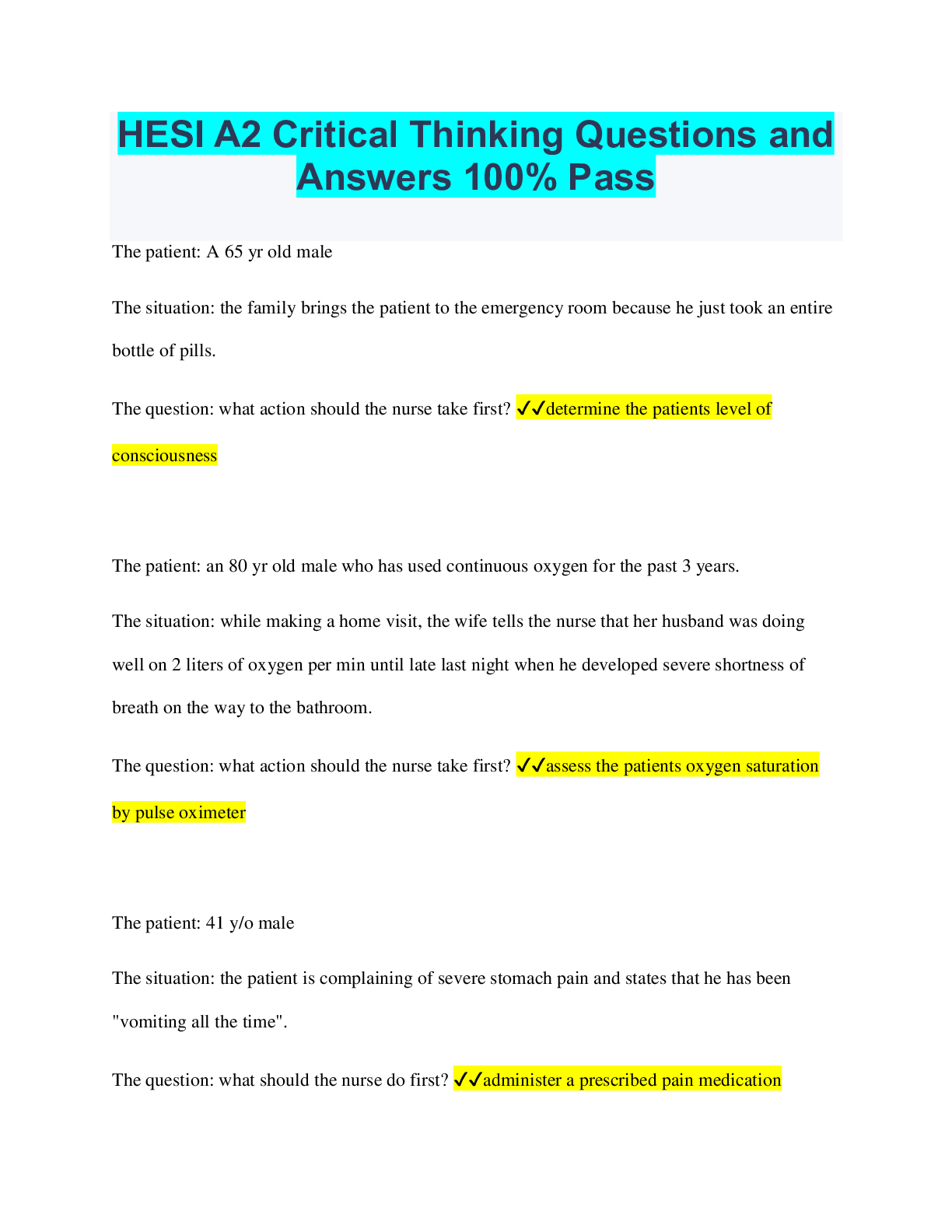
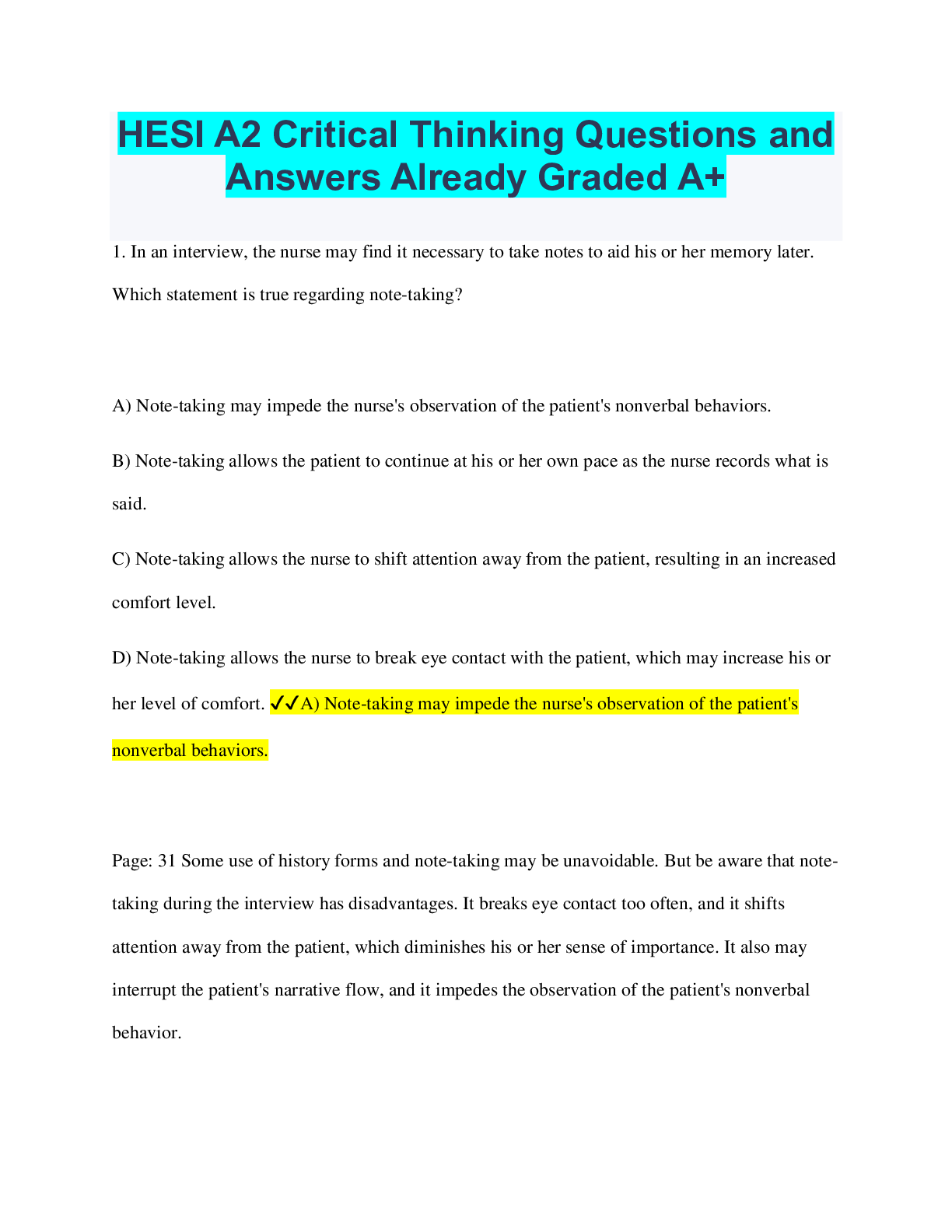
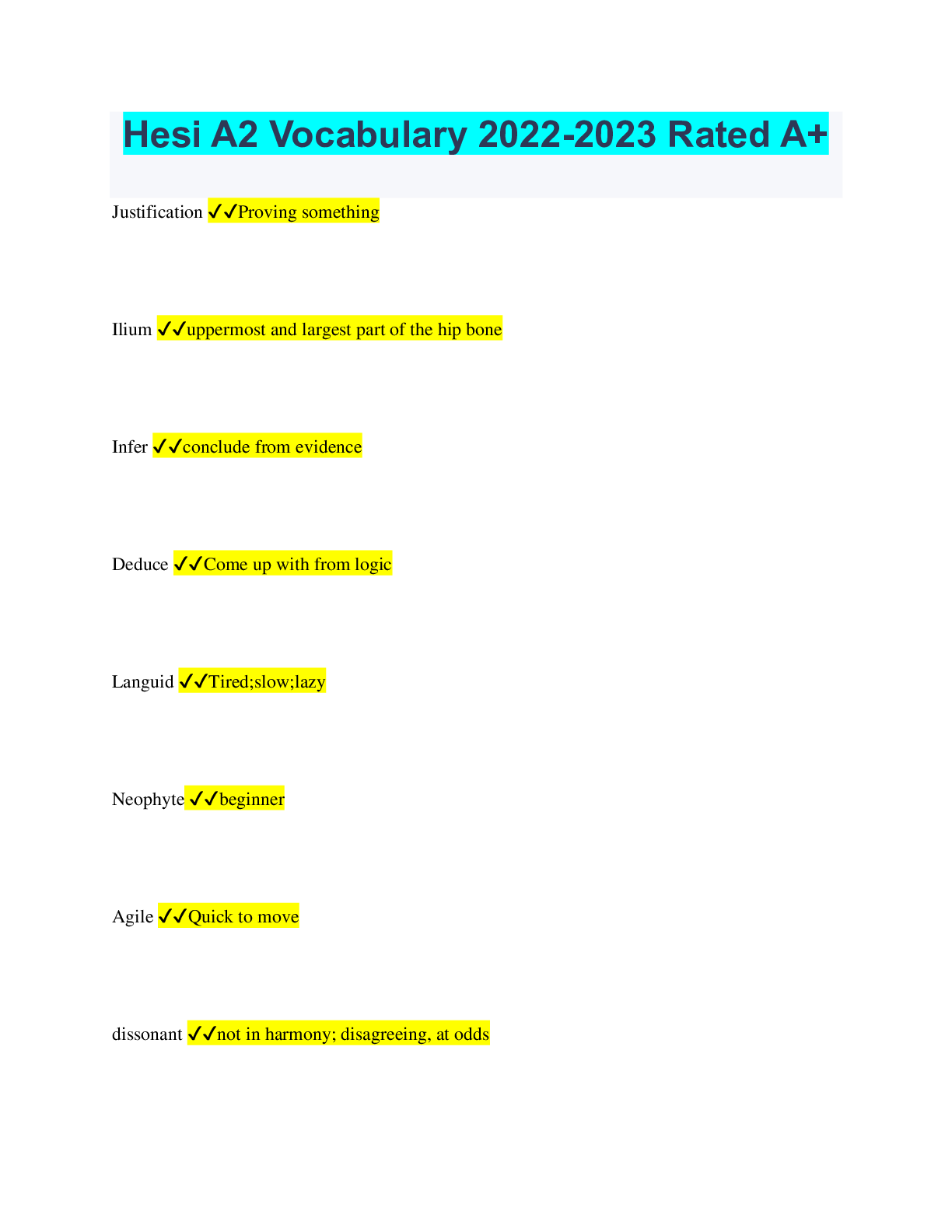
 (1).png)
